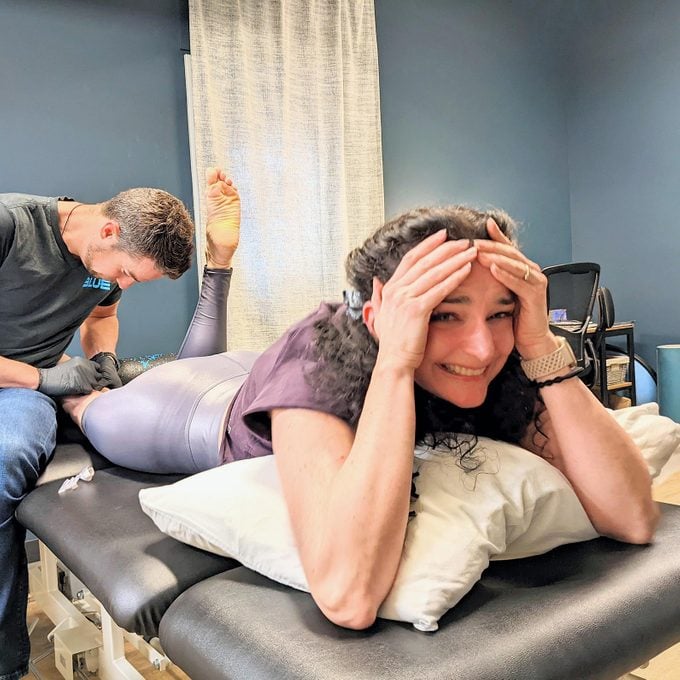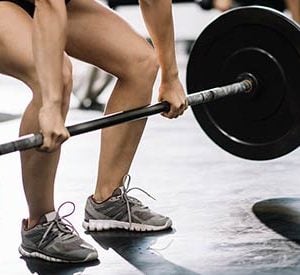Dry Needling for Pain Relief: ‘I Tried It’
Updated: Jun. 08, 2022

When this fitness instructor-journalist went a little too hard in dance cardio class and tore her calf, a cutting-edge medical procedure called "dry needling" helped her get her groove back.
I tore my calf muscle jumping off a stage during my opening number…which sounds much cooler than it actually was. I teach cardio dance classes at a gym, and during the warm-up (that’s right: the nice, easy, slow warm-up), I hopped off the eight-inch-high stage and felt a snap in my left leg. Tears welled in my eyes, and although somehow I pressed on, it was all I could do to finish the class.
Afterward, I went directly to urgent care. I learned that I was going to spend weeks on crutches, and—the scariest part of all—I was at high risk for another similar injury unless I did something different. Fitness is my passion, my outlet, not to mention my job, so the injury scared me enough to actually do something about it. (Rather than just taping it up and living in denial, like I’m known for doing.)
Dry needling is a technique used in physical therapy where monofilament needles are inserted directly into muscle tissue and manipulated to make the muscle relax. It’s beneficial for pain relief, injury or surgery recovery, restoring function, and improving athletic performance.
Here, I share my experience with dry needling to recover from a sports injury.
Come back and read Does Dry Needling Work? 2 Doctors Share This Treatment’s Potential to Heal and Reduce Pain
Trying anything (and everything) to heal
My doctor recommended physical therapy for recovery, strengthening, and prevention. So my fitness instructor friends hooked me up with their go-to physical therapist, Aaron Knighton, a doctor of physical therapy practicing in Boulder, CO. “He’s a miracle worker—you’re going to feel so much better, I promise!” my friend Sam, a cycle instructor and competitive triathlete, told me.
“Just so you know, he’s going to needle you,” casually warned Lisa, a swim coach and triathlete.
Needle me? I didn’t even know what her words meant, but I really didn’t care. By this point, thanks to overcompensating to keep weight off my torn calf, I’d also managed to sprain my right knee. Within a month I’d gone from two good legs to zero.
I was desperate for help.
Over 40? 4 Gentle Mobility Exercises a Trainer Says You Should Be Doing
My first experience dry needling

At my first appointment, Dr. Knighton explained the physiology of what happens in the body when it gets a soft-tissue injury, like a tear, strain, or sprain. “When the body senses the injury, all of the muscles around it tense up to protect and support the area,” he said. “That’s a normal protective mechanism, and it helps in the moment—but these tense spots, called trigger points, can remain even after the initial injury is healed, causing pain, inflammation, loss of function, weakness, and even more injury.”
I had every one of those symptoms. In fact, I hadn’t been able to sleep for weeks. “How do I get rid of trigger points?”
“We release them with needles,” he said. “I insert the needle into the trigger point and manipulate it until it releases. You may feel it pop open or relax, like ice melting on a hot plate.”
Well that sounded lovely! I mean, my friends had done it…and they wouldn’t put me up to anything dangerous, right?
I lay down on my stomach while Dr. Knighton put on gloves. Then he cleaned my calf with rubbing alcohol and opened a sterile package with a tiny filiform needle. So far, so good. I’m not afraid of needles, and the one he held was so little! I relaxed and prepared for something that I expected to feel like a pinprick, acupuncture, or, at worst, a flu shot.
“F***!!!” I screamed and almost shot through the ceiling. “Ah, I’m so sorry!” I gasped, lightning still flashing behind my eyelids.
“Don’t apologize,” he replied, calmly proceeding with the procedure. “Pretty much everyone swears, especially the first time.”
“Did I kick you?”
“No,” he said, “but that’s because I’m holding your leg down.”
Sweat poured from every square inch of my body.
“It’s normal,” Dr. Knighton assured me. “You’re doing great.”
This would be one iteration of a dialogue we’d repeat many times over the next six weeks. “I’m sorry I got your table all wet. I don’t think any of it’s pee.”
“No worries, you’re fine.”
“I’m shaky and light-headed. I’m not fine.”
“I promise you’re fine.”
Each session, I was writhing in pain, sweating and swearing, and Dr. Knighton’s tone was always patient and supportive.
10 Secrets to Finding a Doctor You Can Trust
Benefits of dry needling for injury recovery
Despite the temporary pain during the needling, dry needling did bring some relief. I was very sore and achy for the first couple days after the treatment…but by the next week I felt less pain, better range of motion, and could bear weight on my legs without flinching.
Over the next couple of months I got weekly dry needling treatments in both legs to help with the tear and the sprain. I learned that for me, the foot, hip, and quad weren’t too painful. The hamstring, knee, and inner thigh hurt like hell. I even got one “stim” treatment, where needles were placed into my lower back and upper buttocks region, and then connected to a battery, sending electric currents through me that felt like gentle little bee stings (if there is such a thing). In my experience, nothing ever hurt more than the calves, which I needed to have needled every single time.
I did get better at handling the pain. I’m also proud to report that I never did kick Dr. Knighton, though that might be more due to his skill than my restraint. I learned some coping techniques, including covering my eyes with a cold towel; holding onto the table edge like it was the raft from the final scene in Titanic with Jack and Rose; asking Dr. Knighton to tell me stories about all of his own athletic injuries to distract me; and, yes, on occasion, swearing like a sailor. (This is one of the occasions when it’s widely acceptable to curse.) My friend Lisa, the swim instructor, had also suggested a trick: “You just have to learn to breathe through it.” I never did master her Zen approach.
However, I can definitively say that the pain (and the money, because my insurance covered none of it) was worth it. I’m almost totally recovered. My pain is nearly gone. I can run and jump; I can teach my classes almost normally. I can sit cross-legged on the floor with my dog again—a joy I didn’t realize how much I missed until I couldn’t do it for three months. I can even jump off the stage again!
Dry needling alone isn’t enough
The dry needling alone isn’t responsible for my progress. It was one part of my larger physical therapy program, which also included targeted exercises, stretches, physical manipulation, and wearing braces or taping. Dr. Knighton emphasizes that much research has shown dry needling is most effective when it’s combined with other therapeutic modalities.
But for me, the needling helped release the trigger points (and yes, it does kind of feel like a melting ice cube—the pain gradually dissipates as the procedure continues) so that I could more fully do all the things I need to do to recover.
Get The Healthy @Reader’s Digest newsletter for what’s trending in health and wellness delivered daily. Follow us on Facebook and Instagram, and keep reading:
















